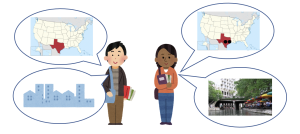Module 42.1 Dialogue
Title
Naomi Johnson asks a stranger for direction

| Language |
Script & Translation
|
Japanese |
|
Romanization |
1 Jonson: Ano, sumimasen.
2 Shiranai hito: Hai, nan desu ka? 3 Jonson: Toshokan wa doko desu ka? 4 Shiranai hito: Asoko ni byouin ga arimasu ne. Toshokan wa ano byouin no migi desu. 5 Jonson: Arigatou gozaimasu. 6 Shiranai hito: Iie, douitashimashite. |
English translation |
1 Johnson: Uh, excuse me.
2 Stranger: Yes, how can I help you? 3 Johnson: Where is the library? 4 Stranger: There is a hospital over there. Library is at the right of that hospital. 5 Johnson: Thank you. 6 Stranger: No problem, you’re welcome. |
Dialogue 1 Vocabulary
Takeshi Yamada asks Naomi Johnson where her hometown is located

| Language |
Script & Translation
|
Japanese |
|
Romanization |
1 : Yamada: Jonson san wa tekisasu no san antonio kara kimashita ne.
2 Jonson: Ee. 3 Yamada: San antonio wa doko ni arimasu ka? 4 Jonson: Hyu-suton no soba ni arimasu. O-suchin ni chikai desu yo. 5 Yamada: San antonio no dauntaun ni nani ga arimasu ka? 6 Jonson: Riba-wo-ku ga arimasu. Riba-wo-ku no chikaku ni ba- to resutoran to shoppu ga arimasu. Ninki kankouchi desu yo. |
English translation |
1 Yamada: Mr. Johnson, you came from San Antonio in Texas, right?
2 Johnson: Yes. 3 Yamada: Where is San Antonio at? 4 Johnson: It is by Houston. It is close to Austin. 5 Yamada: What is in downtown at San Antonio? 6 Johnson: There is Riverwalk. There are bars, restaurants, and shops near the Riverwalk. It is a popular tourist spot. |
Riverwalk image sources: https://commons.wikimedia.org/wiki/File:San_Antonio_downtown_and_Riverwalk.jpg
Dialogue 2 Vocabulary
More Useful Words
Grammar Notes
| Location words: 側 (soba), 近く (chikaku), 横 (yoko), 隣 (tonari), 間 (aida), 右 (migi), and 左 (hidari) |
Just like 上 (ue), 下 (shita), 中 (naka), 前 (mae), and 後ろ (ushiro), 側 (soba), 近く (chikaku), 横 (yoko), 隣 (tonari), 間 (aida), 右 (migi), and 左 (hidari) are words that can be used to describe different positions or directions in space.
| 側 (soba) | near | to indicate something is in a location near or close to something else |
| 近く (chikaku) | near, close | to indicate something is in a location near or within the vicinity of something else |
| 横 (yoko) | (by the) side | to indicate something is besides something else |
| 隣 (tonari) | next to | to indicate something is next to or adjacent to something else |
| 間 (aida) | between | to indicate something is between two things or people |
| 右 (migi) | right | to indicate something is to the right of something else |
| 左 (hidari) | left | to indicate something is to the left of something else |
| How to put 側 (soba), 近く (chikaku), 横 (yoko), 隣 (tonari), 間 (aida), 右 (migi), and 左 (hidari) in a phrase or sentence |
| 机の側 | tsukue no soba | near the desk (lit. desk’s near) |
| 机 | tsukue no soba ni hon ga arimasu. | Near the desk, there is a book. |
| 机の近く | tsukue no chikaku | clost to the desk (lit. desk’s close vincinity) |
| 机の近く に本があります。 | tsukue no chikaku ni hon ga arimasu. | Close to the desk, there is a book. |
| 机の横 | tsukue no yoko | by the desk (lit. desk’s by/side) |
| 箱の横 に本があります。 | tsukue no yoko ni hon ga arimasu. | By to the desk, there is a book. |
| 机の隣 | tsukueno tonari | next to the desk (lit. desk’s next area) |
| 机の隣に | tsukueno tonari ni hon ga arimasu. | Next to the desk, there is a book. |
| 机と椅子の間 | tsukue to isu no aida | between the desk and chair (lit. the desk and chair’s between) |
| 机と椅子の間に本があります。 | tsukue to isu no aida ni hon ga arimasu. | Between the desk and chair, there is a book. |
| 机の右 | tsukue no migi | to the right of the desk (lit. desk’s right) |
| 机の右に本があります。 | tsukue no migi ni hon ga arimasu. | To the right of the desk, there is a book. |
| 机の左 | tsukue no hidari | to the left of the desk (lit. desk’s left) |
| 机の左に本があります。 | tsukue no hidari ni hon ga arimasu. | To the left of the desk, there is a book. |
In summary, we use the following sentence patterns to describe what object, what animal, or who exists at/in/on a location.
| Object | は | Location | に | あります。 |
| Animal | は | Location | に | います。 |
| Person | は | Location | に | います。 |
If one would like to know the location where an object, animal, or person is located, one would use the following sentence patterns:
| Object | は | どこ (doko; where) | に | ありますか。 |
| As for this object, where is it? | ||||
| Animal | は | どこ (doko; where) | に | いますか。 |
| As for this animal, where is it? | ||||
| Person | は | どこ (doko; where) | に | いますか。 |
| As for this person, where is he/she? | ||||
When answering the questions, replace どこ with the exact locations.
し
ひと
なん
としょかん
びょういん
みぎ
やまだ
き
そば
なに
ちか
にんき
かんこうち
よこ
となり
あいだ
ひだり
つくえ
